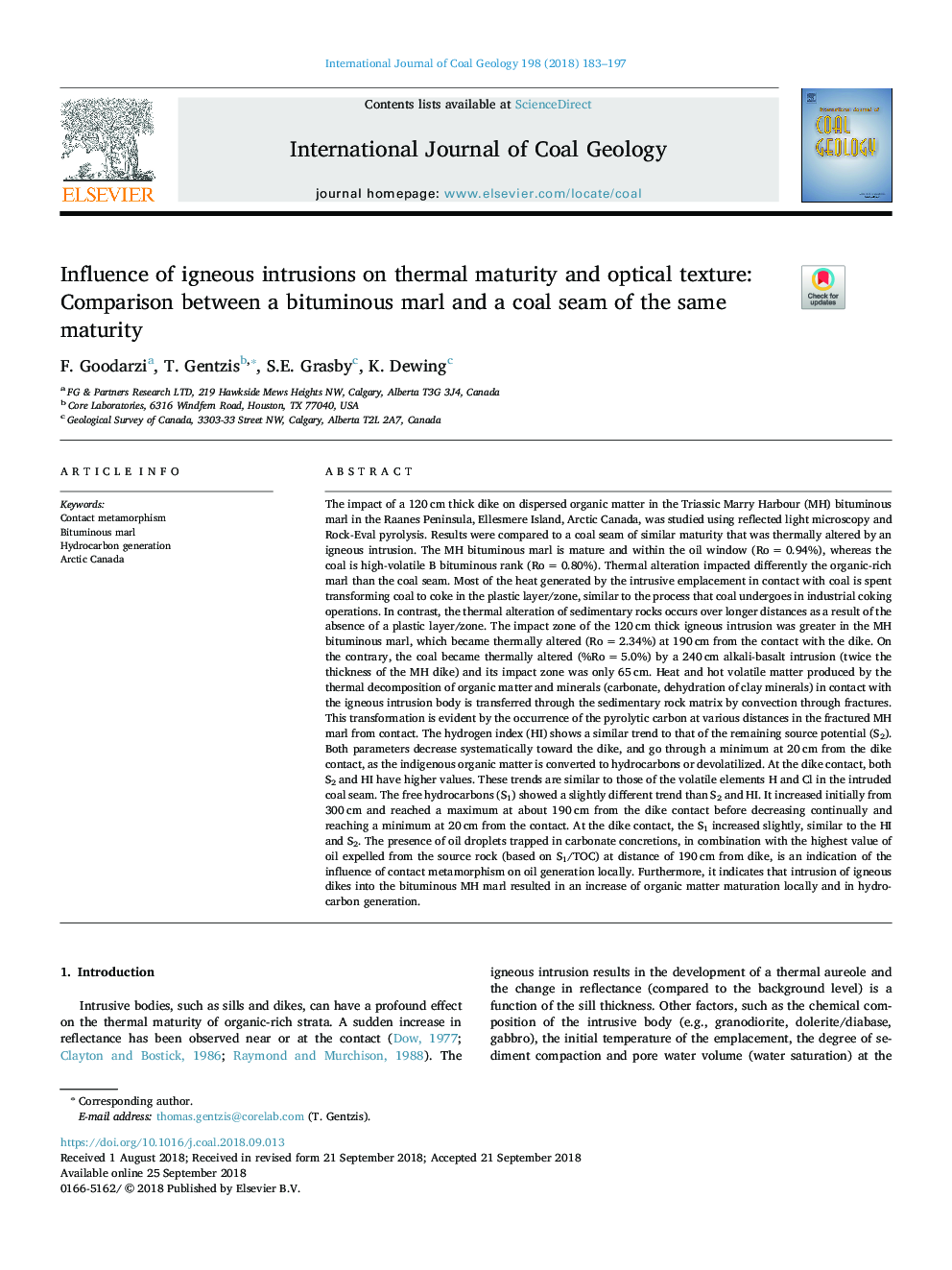| کد مقاله | کد نشریه | سال انتشار | مقاله انگلیسی | نسخه تمام متن |
|---|---|---|---|---|
| 11029478 | 1646509 | 2018 | 15 صفحه PDF | دانلود رایگان |
عنوان انگلیسی مقاله ISI
Influence of igneous intrusions on thermal maturity and optical texture: Comparison between a bituminous marl and a coal seam of the same maturity
ترجمه فارسی عنوان
تأثیر نفوذ بذر بر بلوغ حرارتی و بافت اپتیکی: مقایسه بین مارل بتمنیم و جوش زغال سنگ با همان بلوغ
دانلود مقاله + سفارش ترجمه
دانلود مقاله ISI انگلیسی
رایگان برای ایرانیان
کلمات کلیدی
تماس با دگرگونی، مارن قیر زده، تولید هیدروکربن، قطب شمال کانادا
موضوعات مرتبط
مهندسی و علوم پایه
علوم زمین و سیارات
زمین شناسی اقتصادی
چکیده انگلیسی
The impact of a 120â¯cm thick dike on dispersed organic matter in the Triassic Marry Harbour (MH) bituminous marl in the Raanes Peninsula, Ellesmere Island, Arctic Canada, was studied using reflected light microscopy and Rock-Eval pyrolysis. Results were compared to a coal seam of similar maturity that was thermally altered by an igneous intrusion. The MH bituminous marl is mature and within the oil window (Roâ¯=â¯0.94%), whereas the coal is high-volatile B bituminous rank (Roâ¯=â¯0.80%). Thermal alteration impacted differently the organic-rich marl than the coal seam. Most of the heat generated by the intrusive emplacement in contact with coal is spent transforming coal to coke in the plastic layer/zone, similar to the process that coal undergoes in industrial coking operations. In contrast, the thermal alteration of sedimentary rocks occurs over longer distances as a result of the absence of a plastic layer/zone. The impact zone of the 120â¯cm thick igneous intrusion was greater in the MH bituminous marl, which became thermally altered (Roâ¯=â¯2.34%) at 190â¯cm from the contact with the dike. On the contrary, the coal became thermally altered (%Roâ¯=â¯5.0%) by a 240â¯cm alkali-basalt intrusion (twice the thickness of the MH dike) and its impact zone was only 65â¯cm. Heat and hot volatile matter produced by the thermal decomposition of organic matter and minerals (carbonate, dehydration of clay minerals) in contact with the igneous intrusion body is transferred through the sedimentary rock matrix by convection through fractures. This transformation is evident by the occurrence of the pyrolytic carbon at various distances in the fractured MH marl from contact. The hydrogen index (HI) shows a similar trend to that of the remaining source potential (S2). Both parameters decrease systematically toward the dike, and go through a minimum at 20â¯cm from the dike contact, as the indigenous organic matter is converted to hydrocarbons or devolatilized. At the dike contact, both S2 and HI have higher values. These trends are similar to those of the volatile elements H and Cl in the intruded coal seam. The free hydrocarbons (S1) showed a slightly different trend than S2 and HI. It increased initially from 300â¯cm and reached a maximum at about 190â¯cm from the dike contact before decreasing continually and reaching a minimum at 20â¯cm from the contact. At the dike contact, the S1 increased slightly, similar to the HI and S2. The presence of oil droplets trapped in carbonate concretions, in combination with the highest value of oil expelled from the source rock (based on S1/TOC) at distance of 190â¯cm from dike, is an indication of the influence of contact metamorphism on oil generation locally. Furthermore, it indicates that intrusion of igneous dikes into the bituminous MH marl resulted in an increase of organic matter maturation locally and in hydrocarbon generation.
ناشر
Database: Elsevier - ScienceDirect (ساینس دایرکت)
Journal: International Journal of Coal Geology - Volume 198, 1 October 2018, Pages 183-197
Journal: International Journal of Coal Geology - Volume 198, 1 October 2018, Pages 183-197
نویسندگان
F. Goodarzi, T. Gentzis, S.E. Grasby, K. Dewing,
